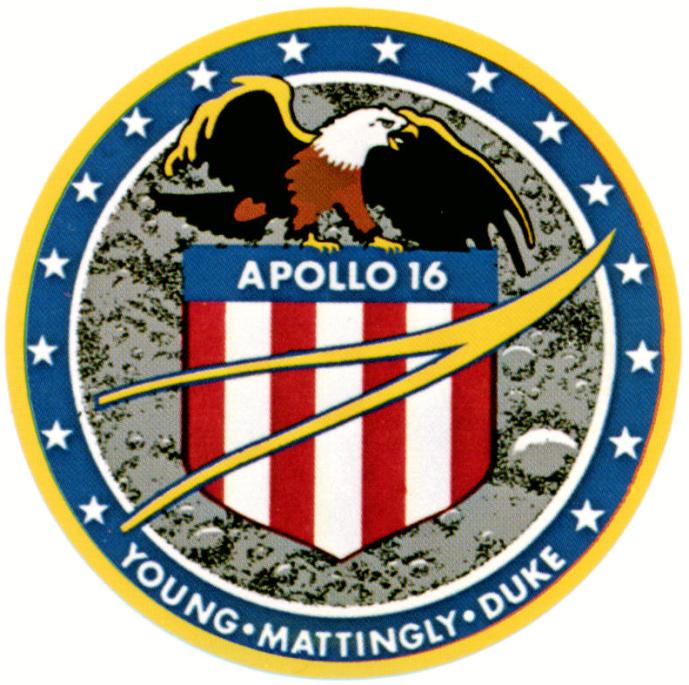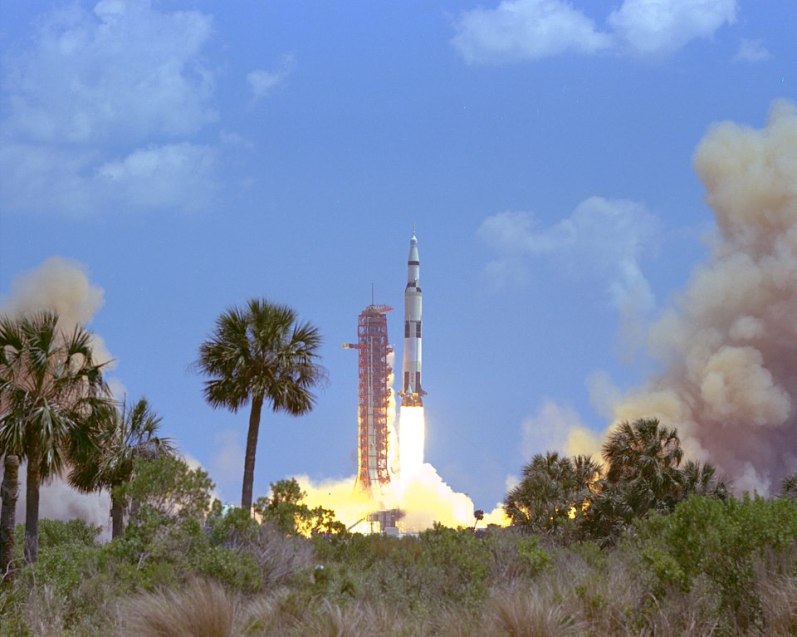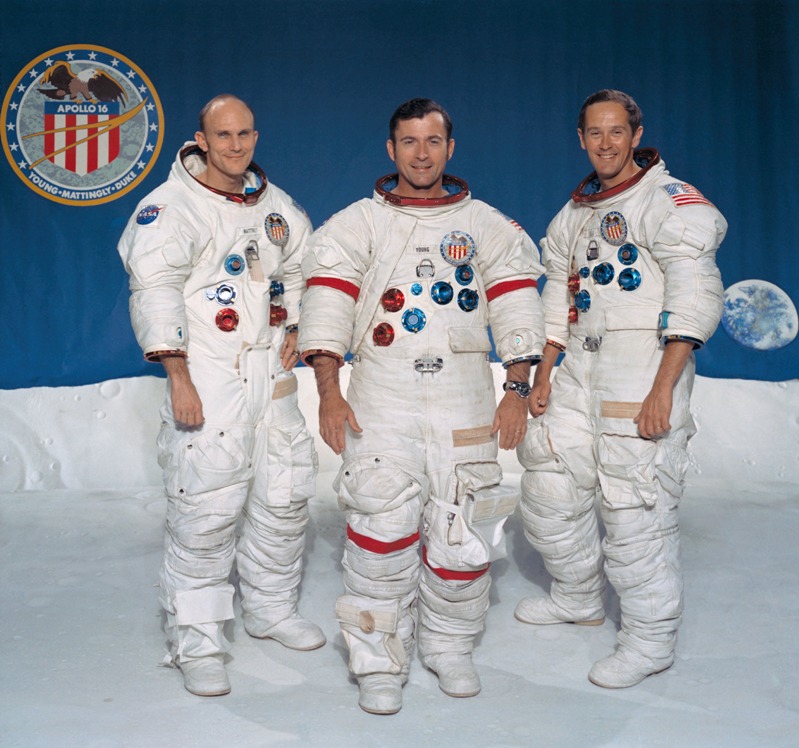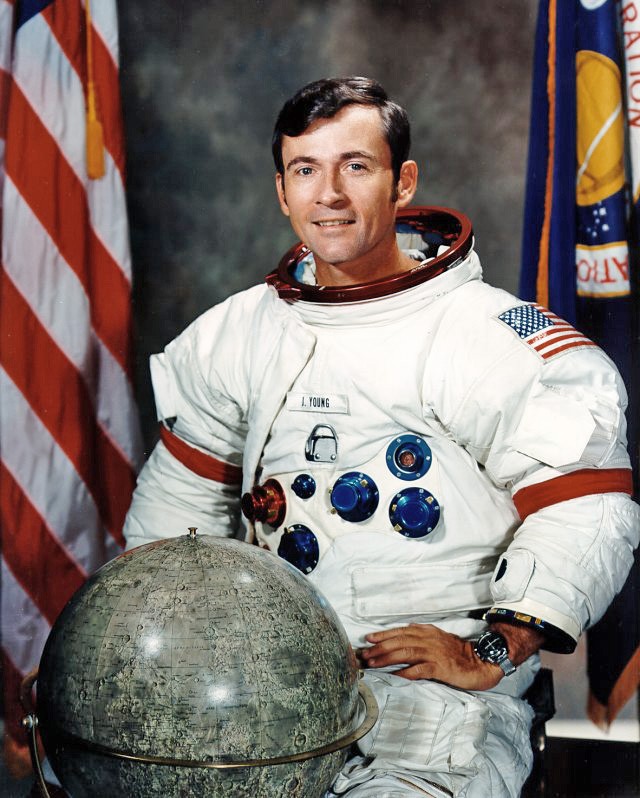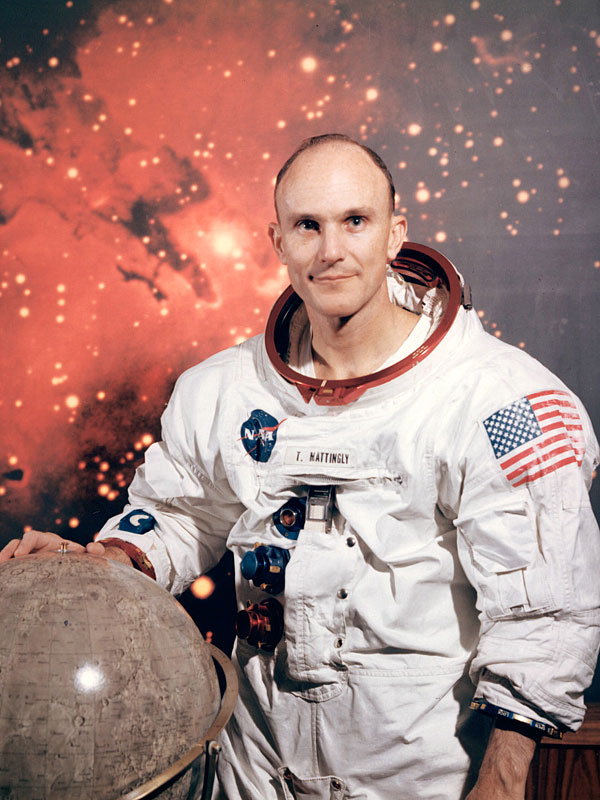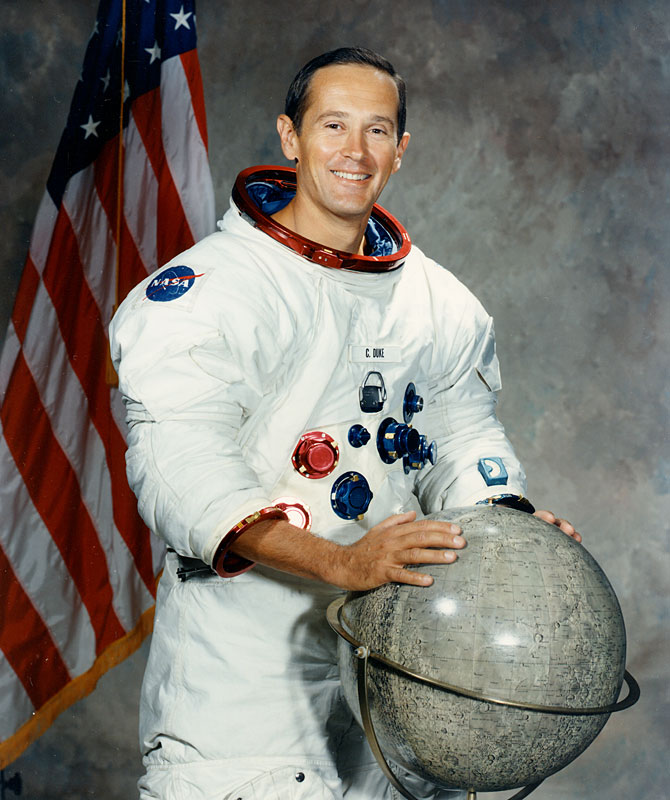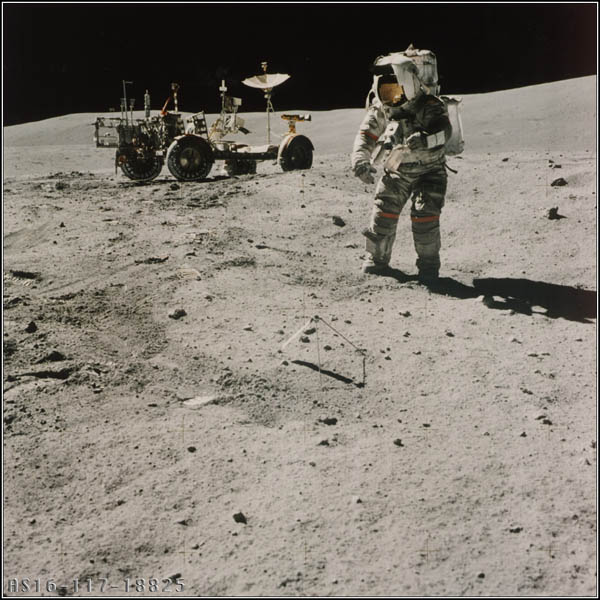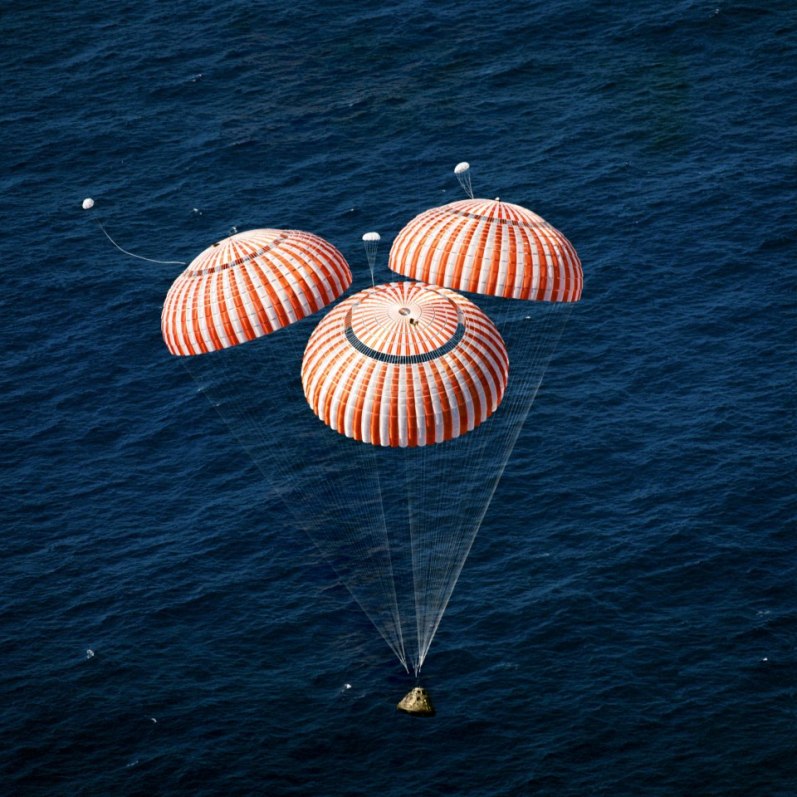
|
||||||||||||
|
|
|
Apollo 16
Launched: 16 April 1972 UT 17:54:00
(12:54:00 p.m. EST)
John W. Young, commander
Mission Commander John Watts Young, Commander, USN
John was born on September 24, 1930 in San Francisco, California. He was educated as an Aeronautical Engineer, receiving a bachelor's degree from Georgia Tech in 1952. After graduation, he joined the U. S. Navy and began flight training a year later. In 1959, he graduated from the U. S. Navy Test Pilot School. John was selected as a member of the second group of pilot-astronauts in 1962, and was the first of the group to be assigned a mission. He flew with Gus Grissom on Gemini 3 and later as Commander of Gemini 10 with Michael Collins. He then served as Command Module Pilot on the Apollo 10 lunar mission and backup Commander on Apollo 13 before landing on the Moon with Charlie Duke on Apollo 16. He and Duke also served as the backup LM crew for Apollo 17. In 1975, Young became the Chief of the Astronaut Office but remained active in development and testing of the Shuttle. He flew as Commander of the first Shuttle flight in April 1981 and flew his sixth space mission in November 1983 as Commander of STS-9. John retired from NASA on 31 December 2004 after serving eight years as Associate Director (Technical), responsible for technical, operational and safety oversight of all Agency Programs and activities assigned to the Johnson Space Center. Command Module Pilot Thomas K. (TK) Mattingly, II, Lt. Commander, USN
TK was born on March 17, 1936 in Chicago, Illinois. He was trained as an aeronautical engineer at Auburn University, receiving his Bachelor's Degree in 1958. At the time of his selection as a member of the fifth group of astronauts, TK was a student at the USAF Aerospace Research Pilot School at Edwards AFB. He served as a member of the support crews for Apollo 8 and 11 and played an important role in the development of the Apollo spacesuit and backpack. Although he was never officially named as a member of the Apollo 11 backup crew, when the original backup Command Module Pilot, Bill Anders, accepted a job at the White House and began to spend increasing amounts of time in Washington, Mattingly began to train in his stead and participated as backup CMP in most of the integrated (full-up) simulations run in the final months before the Apollo 11 launch. He was selected as Command Module Pilot (CMP) for Apollo 13 but was removed from the crew three days prior to launch because of exposure to German measles. The backup CMP, Jack Swigert, took his place and Mattingly subsequently flew as CMP on Apollo 16 with Young and Duke. From 1973 until 1978, Mattingly served as the head of the astronaut support team for the Shuttle program and then served as backup Commander for the second and third missions. In June 1982, Mattingly made his first Shuttle flight as Commander of the fourth mission (STS 4) and, then, in January 1985, commanded the 15th mission, STS-51C. After leaving NASA, he served as Director, Space Sensor Systems, U.S. Navy Space and Naval Warfare Systems Command; and later served as Director, Utilization and Operation, Grumman Space Station Program Support Division, Reston, Virginia. Lunar Module Pilot Charles Moss Duke, Jr., Lt. Colonel, USAF
Charlie was born in Charlotte, North Carolina on October 3, 1935. He graduated from the U.S. Naval Academy in 1957 and then joined the U.S. Air Force which had not yet graduated a class of young officers from its own Academy. After completion of flight training, he served as a fighter interceptor pilot in Germany, and then attended the Massachusetts Institute of Technology, receiving a Master's Degree in Aeronautics in 1964. The following year he graduated from the Air Force Aerospace Research Pilot School and was serving as an instructor when, in April 1966, he was one of 19 pilots selected in the fifth group of astronauts. Charlie served as CapCom during the Apollo 11 landing and as Lunar Module Pilot with Young on the backup crews for Apollo 13 and 17 and on the Apollo 16 prime crew. Duke retired from the Astronaut Corps in 1975 and, later from the U.S. Air Force as a Air Force Reserve Brigadier General. He became active in private business and as a Christian lay witness.
Apollo 16 was the fifth mission in which humans walked on the lunar surface and returned to Earth. On 21 April 1972 two astronauts (Apollo 16 Commander John W. Young and LM pilot Charles M. Duke, Jr.) landed in the Descartes region of the Moon in the Lunar Module (LM) while the Command and Service Module (CSM) (with CM pilot Thomas K. Mattingly, II) continued in lunar orbit. During their stay on the Moon, the astronauts set up scientific experiments, took photographs, and collected lunar samples. The LM took off from the Moon on 24 April and the astronauts returned to Earth on 27 April. Mission Profile Apollo 16 launched on 16 April 1972 at 17:54:00 (12:54:00 p.m. EST) on Saturn V SA-511 from Pad 39A at Kennedy Space Center. (The launch was postponed from the originally scheduled date, March 17, because of a docking ring jettison malfunction.) The spacecraft entered Earth parking orbit at 18:05:56 UT and translunar injection took place at 20:27:37 UT. The CSM and S-IVB stage separated at 20:58:59 UT and CSM-LM docking was achieved at 21:15:53 UT. The S-IVB stage was released into a lunar impact trajectory, but due to an earlier problem with the auxiliary propulsion system (APS) helium regulators, which resulted in continuous venting and loss of helium, the second APS burn could not be made. Tracking of the S-IVB was lost on 17 April at 21:03 UT due to a transponder failure. (The S-IVB stage impacted the Moon on 19 April at 21:02:04 UT at 1.3 N, 23.8 W with a velocity of 2.5 to 2.6 km/s at a 79 degree angle from the horizontal, as estimated from the Apollo 12, 14 and 16 seismic station data.) A mid-course correction was performed at 00:33:01 UT on 18 April. During translunar coast a CSM navigation problem was discovered in which a false indication would cause loss of inertial reference, this was solved by a real-time change in the computer program. The SIM door was jettisoned on 19 April at 15:57:00 UT and lunar orbit insertion took place at 20:22:28 UT. Two revolutions later the orbit was lowered to one with a perilune of 20 km.
At 15:24 UT on 20 April Young and Duke entered the LM. The LM separated from the CSM at 18:08:00 UT, but the LM descent was delayed almost 6 hours due to a malfunction in the yaw gimbal servo loop on the CSM which caused oscillations in the service propulsion system (SPS). Engineers determined that the problem would not seriously affect CSM steering and the miision was allowed to continue with the LM descent. The LM landed at 02:23:35 UT on 21 April in the Descartes highland region just north of the crater Dolland at 9.0 S, 15.5 E. Young and Duke made three moonwalk EVAs totaling 20 hours, 14 minutes. During this time they covered 27 km using the Lunar Roving Vehicle, collected 94.7 kg of rock and soil samples, took photographs, and set up the ALSEP and other scientific experiments. Other experiments were also performed from orbit in the CSM during this time.
The LM lifted off from the Moon at 01:25:48 UT on 24 April after 71 hours, 2 minutes on the lunar surface. After the LM docked with the CSM at 03:35:18 UT the lunar samples and other equipment were transferred from the LM and the LM was jettisoned at 20:54:12 UT on 24 April. The LM began tumbling, apparently due to an open circuit breaker in the guidance and navigation system. As a result the planned deorbit and lunar impact could not be attempted. The LM remained in lunar orbit with an estimated lifetime of one year. The instrument boom which carried the orbital mass spectrometer would not retract and was jettisoned. Because of earlier problems with the SPS yaw gimbal servo loop the mission was shortened by one day. The orbital shaping maneuver was cancelled, and the subsatellite was spring-launched at 21:56:09 UT into an elliptical orbit with a lifetime of one month, rather than the planned one-year orbit. Transearth injection began at 02:15:33 UT on 25 April. On 25 April at 20:43 UT Mattingly began a cislunar EVA to retrieve camera film from the SIM bay and inspect instruments, two trips taking a total of 1 hour, 24 minutes. The CM separated from the SM on 27 April at 19:16:33 UT. Apollo 16 splashed down in the Pacific Ocean on 27 April 1972 at 19:45:05 UT (2:45:05 p.m. EST) after a mission elapsed timeof 265 hrs, 51 mins, 5 secs. The splashdown point was 0 deg 43 min S, 156 deg 13 min W, 215 miles southeast of Christmas Island and 5 km (3 mi) from the recovery ship USS Ticonderoga.
The Apollo 16 Command Module (CM), with astronauts John W. Young, Thomas K. Mattingly II, and Charles M. Duke Jr. aboard, approaching touchdown in the central Pacific Ocean to conclude their lunar landing mission. All its parachutes were fully deployed and a helicopter, from the prime recovery ship USS Ticonderoga, later picked up the three crewmen. (credit:NASA) Performance of the spacecraft, the second of the Apollo J-series missions, was good for most aspects of the mission. The primary mission goals of inspecting, surveying, and sampling materials in the Descartes region, emplacement and activation of surface experiments, conducting inflight experiments and photographic tasks from lunar orbit, engineering evaluation of spacecraft and equipment, and performance of zero-gravity experiments were achieved despite the mission being shortened by one day. Young, 41, was a Navy Captain who had flown on three previous spaceflights (Gemini 3, Gemini 10, and Apollo 10; he later flew on STS-1 and STS-9), Mattingly, 36, was a Navy lt. commander on his first spaceflight (he later flew STS-4 and STS-51C), and Duke, 36, was an Air Force lt. colonel also on his first spaceflight. The backup crew for this mission was Fred Haise, Stuart Roosa, and Edger Mitchell. The Apollo 16 Command Module "Casper" is on display at the Alabama Space and Rocket Center in Huntsville, Alabama. Credit NASA |
